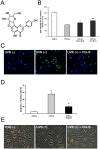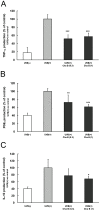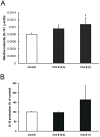Chafuroside B, an Oolong tea polyphenol, ameliorates UVB-induced DNA damage and generation of photo-immunosuppression related mediators in human keratinocytes
- PMID: 24116222
- PMCID: PMC3792907
- DOI: 10.1371/journal.pone.0077308
Chafuroside B, an Oolong tea polyphenol, ameliorates UVB-induced DNA damage and generation of photo-immunosuppression related mediators in human keratinocytes
Abstract
Chafuroside B was recently isolated as a new polyphenolic constituent of oolong tea leaves. However, the effects of chafuroside B on skin function have not been examined. In this study, we investigated the protective effects of chafuroside B against UVB-induced DNA damage, apoptosis and generation of photo-immunosuppression related mediators in cultured normal human epidermal keratinocytes (NHEK). Chafuroside B at 1 µM attenuated both UVB-induced apoptosis, evaluated in terms of caspase-3/7 activity, and UVB-induced DNA damage, evaluated in terms of formation of cyclobutane pyrimidine dimers (CPD), in NHEK exposed to UVB (20 mJ/cm2). In addition, chafuroside B at 0.3 or 1 µM suppressed the UVB-induced production of interleukin (IL)-10, tumor necrosis factor (TNF)-α, and prostaglandin E2 (PGE2), as determined by ELISA, and conversely enhanced IL-12 mRNA expression and production, as measured by RT-PCR and ELISA. Further, chafuroside B at 1 µM also suppressed UVB-induced expression of receptor activator of nuclear factor κB ligand (RANKL) mRNA. These results indicate that chafuroside B promotes repair of UVB-induced DNA damage and ameliorates the generation of IL-10, TNF-α, PGE2, and RANKL, all of which are UVB-induced immunosuppression related mediators. These effects of chafuroside B may be mediated at least in part through induction of IL-12 synthesis in human keratinocytes. Because chafuroside B might have practical value as a photoprotective agent, a further study of the in vivo effects of chafuroside B seems warranted.
Conflict of interest statement
Figures




Similar articles
-
Crystal Structures of Flavone C-Glycosides from Oolong Tea Leaves: Chafuroside A Dihydrate and Chafuroside B Monohydrate.Chem Pharm Bull (Tokyo). 2019;67(9):935-939. doi: 10.1248/cpb.c19-00166. Chem Pharm Bull (Tokyo). 2019. PMID: 31474732
-
Antagonizing effects and mechanisms of afzelin against UVB-induced cell damage.PLoS One. 2013 Apr 23;8(4):e61971. doi: 10.1371/journal.pone.0061971. Print 2013. PLoS One. 2013. PMID: 23626759 Free PMC article.
-
Inhibitory effects of Baicalin on ultraviolet B-induced photo-damage in keratinocyte cell line.Am J Chin Med. 2008;36(4):745-60. doi: 10.1142/S0192415X0800620X. Am J Chin Med. 2008. PMID: 18711771
-
Measurement of UVB-Induced DNA damage and its consequences in models of immunosuppression.Methods. 2002 Sep;28(1):55-62. doi: 10.1016/s1046-2023(02)00209-8. Methods. 2002. PMID: 12231188 Review.
-
Role of tumor necrosis factor-α in the regulation of keratinocyte cell cycle and DNA repair after ultraviolet-B radiation.Dan Med Bull. 2010 Oct;57(10):B4179. Dan Med Bull. 2010. PMID: 21040686 Review.
Cited by
-
Genome-Protecting Compounds as Potential Geroprotectors.Int J Mol Sci. 2020 Jun 24;21(12):4484. doi: 10.3390/ijms21124484. Int J Mol Sci. 2020. PMID: 32599754 Free PMC article. Review.
-
Synthesis of bicyclic ethers by a palladium-catalyzed oxidative cyclization-redox relay-π-allyl-Pd cyclization cascade reaction.Chem Commun (Camb). 2019 Jun 21;55(49):7013-7016. doi: 10.1039/c9cc03775f. Epub 2019 May 31. Chem Commun (Camb). 2019. PMID: 31147660 Free PMC article.
-
A Systematic Review of Keratinocyte Secretions: A Regenerative Perspective.Int J Mol Sci. 2022 Jul 19;23(14):7934. doi: 10.3390/ijms23147934. Int J Mol Sci. 2022. PMID: 35887279 Free PMC article.
-
Modulating effects of oral administration of Lycii Fructus extracts on UVB-induced skin erythema: A Randomized, placebo-controlled study.Biomed Rep. 2022 Jun 1;17(1):62. doi: 10.3892/br.2022.1545. eCollection 2022 Jul. Biomed Rep. 2022. PMID: 35719836 Free PMC article.
-
Topical Formulation Containing Naringenin: Efficacy against Ultraviolet B Irradiation-Induced Skin Inflammation and Oxidative Stress in Mice.PLoS One. 2016 Jan 7;11(1):e0146296. doi: 10.1371/journal.pone.0146296. eCollection 2016. PLoS One. 2016. PMID: 26741806 Free PMC article.
References
-
- Verschooten L, Claerhout S, Van Laethem A, Agostinis P, Garmyn M (2006) New strategies of photoprotection. Photochem Photobiol 82: 1016–1023. - PubMed
-
- Moriwaki S, Takahashi Y (2008) Photoaging and DNA repair. J Dermatol Sci 50: 169–176. - PubMed
-
- Cooper KD, Oberhelman L, Hamilton TA, Baadsgaard O, Terhune M, et al. (1992) UV exposure reduces immunization rates and promotes tolerance to epicutaneous antigens in humans: relationship to dose, CD1a-DR+ epidermal macrophage induction, and Langerhans cell depletion. Proc Natl Acad Sci USA 89: 8497–8501. - PMC - PubMed
-
- Kripke ML, Cox PA, Bucana C, Vink AA, Alas L, et al. (1996) Role of DNA damage in local suppression of content hypersensitivity in mice by UV radiation. Exp Dermatol 5: 173–180. - PubMed
Publication types
MeSH terms
Substances
LinkOut - more resources
Full Text Sources
Other Literature Sources
Research Materials

